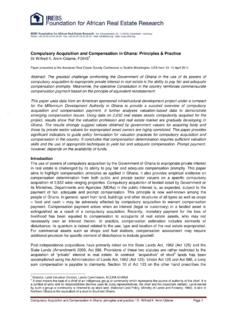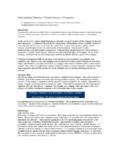Transcription of Valuation of a Cable Television System
1 Valuation of a Cable Television System by Zareer Pavri, Manager, Price Waterhouse, Toronto General Background The Cable Television industry is capital intensive, requiring large capital expenditures at the outset to put the required plant and physical facilities in place and subsequently, on a periodic basis. Improving technology tends to necessitate System rebuilds every few years. In 1975 and 1976, for example, many Canadian CATV companies injected a great deal of capital to expand their systems beyond 12 channels. Today, CATV systems are being designed to 36 and 47-channel capacity to accommodate new technology and services either presently or soon to be available.
2 CATV is also predictable from an operating cash flow standpoint. Given the characteristics of the System , such as more homes, penetration levels, staff and operating expense requirements, revenues and expenses can be predicted fairly accurately. The main areas of uncertainty, however, relate to economic conditions as they affect housing starts and timing of capital projects. Originally merely an aid to basic Television , CATV has mushroomed into an integral part of the Canadian broadcasting industry, currently servicing over 5 million subscribers. Looked at from a global perspective, CATV is a $5 billion industry, essentially limited to the United States and Canada, but with signs of making inroads into the United Kingdom. Cable s potential, or perceived potential, has generated so much acquisition activity in recent times that it almost rivals energy and natural resources industries.
3 Valuation Methodology The value of a Cable Television business is usually determined by reference to the following methods: capitalization of maintainable earnings, discounted cash flow, multiple of Cable cash flow and value per subscriber. A computation of adjusted tangible equity on a going-concern basis is not as relevant to a Cable company Valuation as it is with other businesses since this method does not consider the significant value normally attributable to the Cable company s exclusive franchise to operate in a specific area. The methods of valuing a Cable company on a going-concern basis are discussed below. Capitalization of Maintainable Earnings Under this method, fair market value is established by capitalizing estimated maintainable earnings. The two key elements here are the estimated maintainable earnings and the capitalization rate or earnings multiple -- selected.
4 Maintainable after-tax earnings are the net earnings generated from normal operations, which can reasonably be assumed to be achievable in the future. The idea is to estimate the basic earning capacity of the operating assets of a company. Normally, this is done by reviewing past performance, excluding unusual or non-recurring items, and forecasts of future operations. However, in its formative years, a Cable company must make significant capital investments before achieving a reasonable subscriber base. It is, therefore, not unusual for junior Cable companies to incur losses for several years, thus making futile any attempt to try to determine the level of maintainable earnings. Furthermore, since the CATV industry is continually developing new services, current and historical earnings cannot reflect the potential benefits to be derived from them.
5 A capitalization rate, or earnings multiple, is basically a quantified synthesis of expected business risk, earnings growth potential and rates of return available from alternate investment opportunities. An appropriate earnings multiple cannot be determined by a simple analysis of these three factors, however, for they are highly inter-related and usually influenced by many other factors, such as: inherent business risks attaching to the Cable TV company; stability of earnings; quality of anticipated earnings; and the economic and political climate prevailing at the Valuation date. While expectations of normal growth in the level of maintainable earnings can usually be reflected in an earnings multiple, potential from and timing of developments in the type of new services simply cannot be incorporated to any meaningful degree in an earnings multiple.
6 Discounted Cash Flow Projected cash flows (defined as after-tax profits from the Cable TV operations plus non-cash charges to income such as depreciation and deferred taxes less estimated sustaining capital reinvestment) are present-valued using an appropriate discount rate. The important elements here are: the ability to project cash flows with a reasonable degree of accuracy; the time horizon selected; the residual value of the Cable TV System at the end of this time horizon; and, the discount rate incorporating the inherent risk in this business. Using this technique, estimated cash flows of Cable companies generally exclude interest expense. Instead, the balance of long-term debt at the start of the cash flow model is deducted from the present value of future cash flows, excluding interest expense. Long-term debt in the Cable industry is normally incurred only for fixed asset additions; not for day to day operations.
7 A new System requires significant fixed asset additions in the initial years of the System and, to the extent that this is financed by debt, such loans are often repaid quickly out of cash flow generated once the System is in place. However, the proportionate share of debt is a variable that the Cable operator can control. Thus, handling long-term debt as explained previously is useful in segregating the investment decision from the financing decision. While accurate cash flow projections are difficult in most industries due to volatile customer preferences, Cable company cash flows can be predicted with reasonable accuracy. The relationship between costs and revenues tends to remain fairly constant over time. Penetration rates and saturation levels can be estimated by reference to historical experience, anticipated housing starts and population growth in the licensed area.
8 In determining cash flow, one must assess both the company s hardware and its intangible assets, mainly its CATV license. Hardware consists of transmission towers, control centre, distribution centres on poles and underground trucks, tools and converters. A potential acquirer must ask if the systems are the newer high channel-capacity ones; whether the channels have to be updated by the acquirer and whether there is a large piece of real estate involved. Acquirers must also keep in mind the intangible factor causing Cable systems to fluctuate in their cash flow evaluation: the franchise in the community or the CATV license. Generally speaking, the more undeveloped a basic Cable TV System , the greater the potential and hence the greater the value of the CATV license. With the advent of new services, however, licenses of mature Cable Television companies will probably still have substantial value because there is a large base of existing subscribers who will want these new services.
9 At the end of the cash flow forecast period, the residual value of the Cable TV System must be determined as part of the company s total value. In the case of a mature Cable company, with no foreseeable new major capital expenditures and annual depreciation expense approximating annual fixed asset additions, it would be appropriate to capitalize maintainable earnings in the last year of the forecast model and discount the capitalized earnings value at the end of the forecast model to present value. However, in the case of a junior Cable TV System , whose fixed asset additions incurred in the first few years may still be depreciating in year ten of the cash flow model (generally the last year of the forecast model), capitalization of year ten net income may result in double-counting certain fixed asset additions. Consequently, it is appropriate in the case of junior Cable companies that have not quite reached their target saturation levels, or mature companies planning significant capital outlays, to capitalize the last year s cash flow in order to arrive at an estimated residual value for the company.
10 The discount rate used to estimate the present value of projected cash flows is determined by using factors similar to those used for determination of the capitalization rate or earnings multiple. It should be noted, however, that when projected cash flows include an inflation component, it is necessary to build this into the discount rate selected because value is measured in current dollars. No such adjustment in an earnings multiple is necessary, since maintainable earnings exclude the impact of future inflation. Rules of Thumb There are two generally accepted rules of thumb in the Cable industry: multiple of Cable cash flow and value per subscriber. Cable cash flow is defined as operating income before depreciation, amortization, interest and taxes. Current Cable acquisition prices in Canada range between 3 and 5 times current year s Cable cash flow, while those in the range between 9 and 11 times next year s Cable cash flow.






